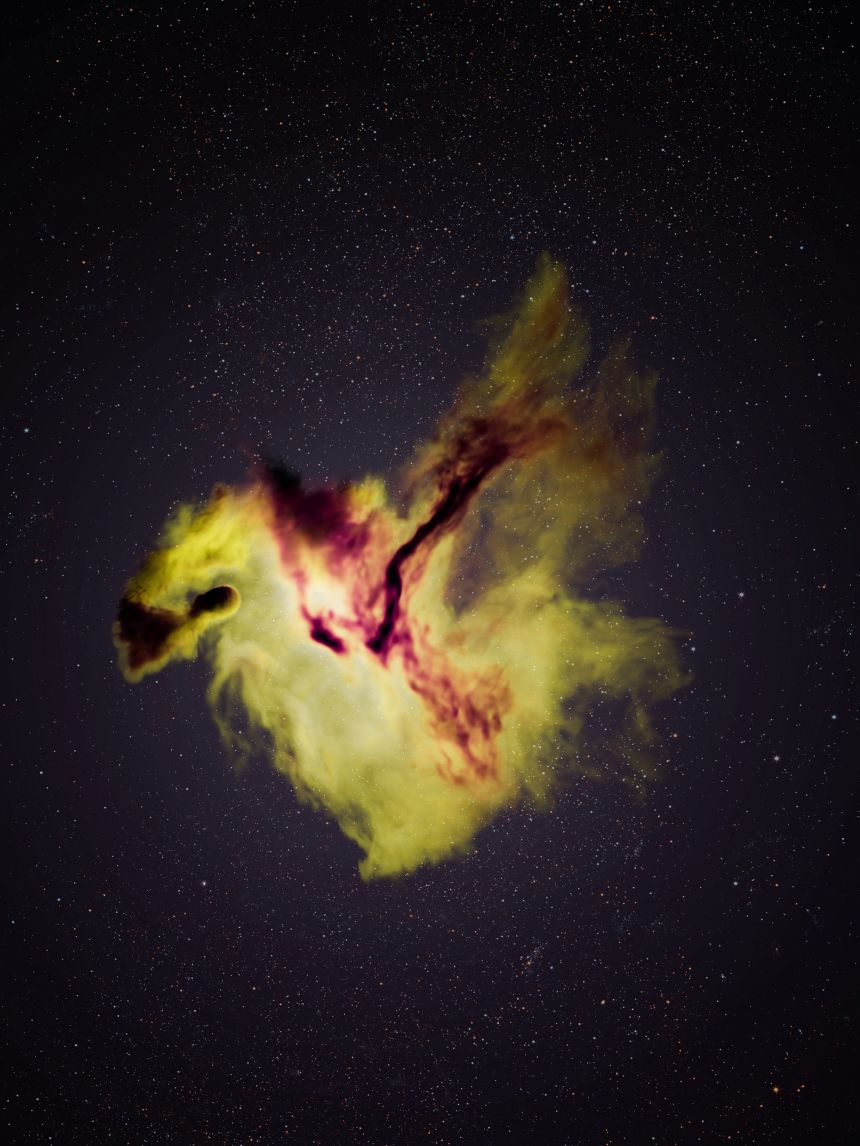Astronomers have observed what they are calling a new type of supernova, which has provided an unparalleled glimpse into what happens deep within a star just before it explodes.
A study detailing the surprising discovery published Wednesday in the journal Nature.
Massive stars are like celestial onions: the outermost layers are made up of lightweight elements such as hydrogen and helium while layers of heavier elements lay underneath.
These stars, which can be 10 to 100 times heavier than our sun, are powered by nuclear fusion, a process in which lighter elements are fused together to create heavier ones.
Stars begin with a composition of about 75% hydrogen and 25% helium, with small amounts of carbon, nitrogen, silicon and other elements, said study coauthor Adam Miller, assistant professor of physics and astronomy at Northwestern University.
Through fusion, which takes place at the center of the star where the temperature and density are the highest, hydrogen is converted into helium to create the outer layers of the onion structure. Over a star’s lifetime, the process continues, fusing together lighter elements to form heavier ones and, over time, adding internal layers of silicon, sulfur, oxygen, neon, magnesium, carbon beneath the helium and hydrogen.
At the very end of the star’s life, after all of the gaseous layers have formed, the iron core of the star forms, Miller explained.
Fusion releases energy, which produces pressure that prevents stars from collapsing in on themselves due to gravity, Miller said. But when stars try to fuse the iron at their core into heavier elements, there isn’t enough energy to continue providing pressure. As a result, the star’s core collapses under the force of gravity, leading to a stellar explosion.
However, nothing went as expected when astronomers observed a first-of-its-kind supernova named SN2021yfj. At some point well before the explosion, the star had already lost its outer layers of hydrogen, helium and carbon. Then, just before exploding, the star released a typically hidden layer of relatively heavy elements such as silicon, sulfur and argon that are not often seen in dying stars.
The star’s explosion “illuminated” the expelled layer of silicon, sulfur and argon, which had never been seen before, Miller said.
“This is the first time we have seen a star that was essentially stripped to the bone,” lead study author Steve Schulze, a research associate at Northwestern University’s Center for Interdisciplinary Exploration and Research in Astrophysics, said in a statement.
“It shows us how stars are structured and proves that stars can lose a lot of material before they explode. Not only can they lose their outermost layers, but they can be completely stripped all the way down and still produce a brilliant explosion that we can observe from very, very far distances.”
The discovery provides direct evidence of the long-theorized, but difficult to observe, internal structure of massive stars. It is also challenging the conventional ways in which astronomers understand stellar evolution.
“This event quite literally looks like nothing anyone has ever seen before,” Miller said in a statement.
“It was almost so weird that we thought maybe we didn’t observe the correct object. This star is telling us that our ideas and theories for how stars evolve are too narrow. It’s not that our textbooks are incorrect, but they clearly do not fully capture everything produced in nature. There must be more exotic pathways for a massive star to end its life that we hadn’t considered.”
The study authors don’t know exactly what type of star existed before the supernova, but they believe it had a mass about 60 times heavier than the sun, Schulze and Miller said. However, because the outer hydrogen layer of the star had already been stripped away prior to the explosion, the star’s mass was likely smaller when it became a supernova than when it was born, Miller added.
Massive stars have been known to shed outer layers of material before exploding, but this star lost much more than what had been previously observed. For instance, astronomers have seen stars that have been stripped of their hydrogen layer, but are still cloaked in helium, carbon and oxygen.
“Stars experience very strong instabilities,” Schulze said. “These instabilities are so violent that they can cause the star to contract. Then, it suddenly liberates so much energy that it sheds its outermost layers. It can do this multiple times.”
In some massive star explosions, elements like silicon and sulfur can be observed “mixed” with all the other elements as part of the ejected material — but they haven’t been seen prior to a supernova before, Miller said.
The team estimated that the star would have needed to release a mass of three times the sun over the course of its lifetime to leave behind the silicon and sulfur shell, suggesting that some stars experience extreme losses of mass later in their lifetimes.
In this unique supernova, the team observed a thick shell of silicon and sulfur being expelled just before the star’s death. When the star exploded, the material from its core collided with the gaseous shell, and the heat of the collision caused the silicon and sulfur layer to glow.
“This star lost most of the material that it produced throughout its lifetime,” Schulze said. “So, we could only see the material formed during the months right before its explosion. Something very violent must have happened to cause that.”
The team discovered the supernova in September 2021 while using the Zwicky Transient Facility at the Palomar Observatory in Southern California. Zwicky, which scans the night sky with a wide-field camera, has a reputation for enabling astronomers to discover transients, or fleeting cosmic phenomena, such as quickly flaring and fading supernovas.
Looking over the data for evidence of supernovas, Schulze noticed an object that rapidly increased in brightness 2.2 billion light-years from Earth. (A single light-year is a measure of how long it takes light to travel to Earth, so the increase in brightness occurred 2.2 billion years ago.)
To better understand what they were looking at, the team wanted to see a spectrum for the object — wavelengths of colored light, with each color signifying a different element. Capturing a spectrum was not possible with Zwicky because it only measures changes in overall brightness. At first, it seemed that no other telescopes were able to capture a clear image of the supernova. But Yi Yang, now an assistant professor at China’s Tsinghua University, spotted the object while observing with the W. M. Keck Observatory in Hawaii and captured a spectrum.
Typically the search for supernovas is done with small telescopes that measure brightness like Zwicky, Miller said, and then larger telescopes like Keck are used to understand the chemical composition of the gas that was ejected by the explosion.
“Without that spectrum,” Miller said, “we may have never realized that this was a strange and unusual explosion.”
The team shared the spectrum with Avishay Gal-Yam, dean of the faculty of physics and professor of particle physics at Israel’s Weizmann Institute of Science. Gal-Yam, a coauthor on the study and a leading expert in supernova science, identified the mysterious features in the spectrum that turned out to be silicon, sulfur and argon, Schulz said.

The team remains unsure of what triggered the star to release the silicon and sulfur shell and is considering the possibility that the star interacted with a potential companion star, experienced exceptionally strong stellar winds or underwent a massive pre-supernova outburst.
However, the study authors are leaning toward the idea that the star tore itself apart.
Whatever the cause, the team has designated its discovery as an entirely new type of supernova called a type Ien (pronounced one-e-n) supernova, Miller said.
Supernova classifications are based on the presence of different elements. Type II supernovas include hydrogen, while type Ib have helium but no hydrogen, and type Ic have oxygen but no helium or hydrogen. Each type of supernova exposes deeper layers of a star.
“We tend to think of massive stars forming a sequence,” Miller said. “We call this new discovery a Ien SN because the silicon, sulfur and argon would be present only in the deepest, innermost layers of a massive star.”
Stefano Valenti, an associate professor in the department of physics and astronomy at the University of California, Davis, had never seen a spectrum like the one in the study. While Valenti has studied unusual supernovas, he was not involved in this research.
“It is clearly something new,” Valenti said. “This discovery is showing us that the zoo of astronomical transients is still not complete and that large wide surveys like (Rubin Observatory) will probably give us the opportunity to discover new types of transients.”
Only having one example of a supernova type underscores the need to find other cases of this type to better understand their nature, Miller said, but it will be tricky. While the Vera C. Rubin Observatory could spot at least 1 million supernovas, it does not measure their spectrums. In its paper, the team showed that a simple machine learning model would not have identified the supernova as rare based on its brightness alone.
“To me the big open question is — how often do such explosions occur in the Universe?” Miller wrote in an email “Did we happen to just get incredibly, incredibly lucky? Or, are there a lot of these out there and we haven’t been searching in the correct way to find more?”
Sign up for CNN’s Wonder Theory science newsletter. Explore the universe with news on fascinating discoveries, scientific advancements and more.


